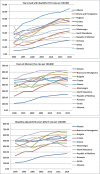The burden of breast, cervical, and colon and rectum cancer in the Balkan countries, 1990-2019 and forecast to 2030
- PMID: 37620889
- PMCID: PMC10464494
- DOI: 10.1186/s13690-023-01137-9
The burden of breast, cervical, and colon and rectum cancer in the Balkan countries, 1990-2019 and forecast to 2030
Abstract
Background: Despite effective prevention and control strategies, in countries of the Balkan region, cancers are the second leading cause of mortality, closely following circulatory system diseases.
Objective: To describe trends in the burden of breast, cervical, and colon and rectum cancer in the Balkan region and per country between 1990 and 2019, including a forecast to 2030.
Methods: We described the 2019 Global Burden of Disease (GBD) estimates for breast, cervical, and colon and rectum cancers in eleven Balkan countries over the period 1990-2019, including incidence, years lived with disability (YLD), years of life lost (YLL), and disability-adjusted life years (DALYs) rates per 100,000 population and accompanied 95% uncertainty interval. With the Autoregressive Integrated Moving Average, we forecasted these rates per country up to 2030.
Results: In the Balkan region, the highest incidence and DALYs rates in the study period were for colon and rectum, and breast cancers. Over the study period, the DALYs rates for breast cancer per 100,000 population were the highest in Serbia (reaching 670.84 in 2019) but the lowest in Albania (reaching 271.24 in 2019). In 2019, the highest incidence of breast cancer (85 /100,000) and highest YLD rate (64 /100,000) were observed in Greece. Romania had the highest incidence rates, YLD rates, DALY rates, and YLL rates of cervical cancer, with respective 20.59%, 23.39% 4.00%, and 3.47% increases for the 1990/2019 period, and the highest forecasted burden for cervical cancer in 2030. The highest incidence rates, YLD rates and DALY rates of colon and rectum cancers were continuously recorded in Croatia (an increase of 130.75%, 48.23%, and 63.28%, respectively), while the highest YLL rates were in Bulgaria (an increase of 63.85%). The YLL rates due to colon and rectum cancers are forecasted to progress by 2030 in all Balkan countries.
Conclusion: As most of the DALYs burden for breast, cervical, and colon and rectum cancer is due to premature mortality, the numerous country-specific barriers to cancer early detection and quality and care continuum should be a public priority of multi-stakeholder collaboration in the Balkan region.
© 2023. BioMed Central Ltd., part of Springer Nature.
Conflict of interest statement
The authors declare no competing interests.
Figures



References
-
- United Nations. Sustainable development goals. 2015. Available from: http://www.un.org/sustainabledevelopment/.
-
- Abbafati C, Abbas KM, Abbasi-Kangevari M, Abd-Allah F, Abdelalim A, Abdollahi M, et al. Global burden of 369 diseases and injuries in 204 countries and territories, 1990–2019: a systematic analysis for the Global Burden of Disease Study 2019. Lancet. 2020;396(10258):1204–1222. doi: 10.1016/S0140-6736(20)30925-9. - DOI - PMC - PubMed
-
- WHO World Health Organization. World Health Organization. health topics. Cervical cancer. Overview. 2021. Available from: https://www.who.int/health-topics/cervical-cancer?__cf_chl_captcha_tk__=....
LinkOut - more resources
Full Text Sources
Research Materials

